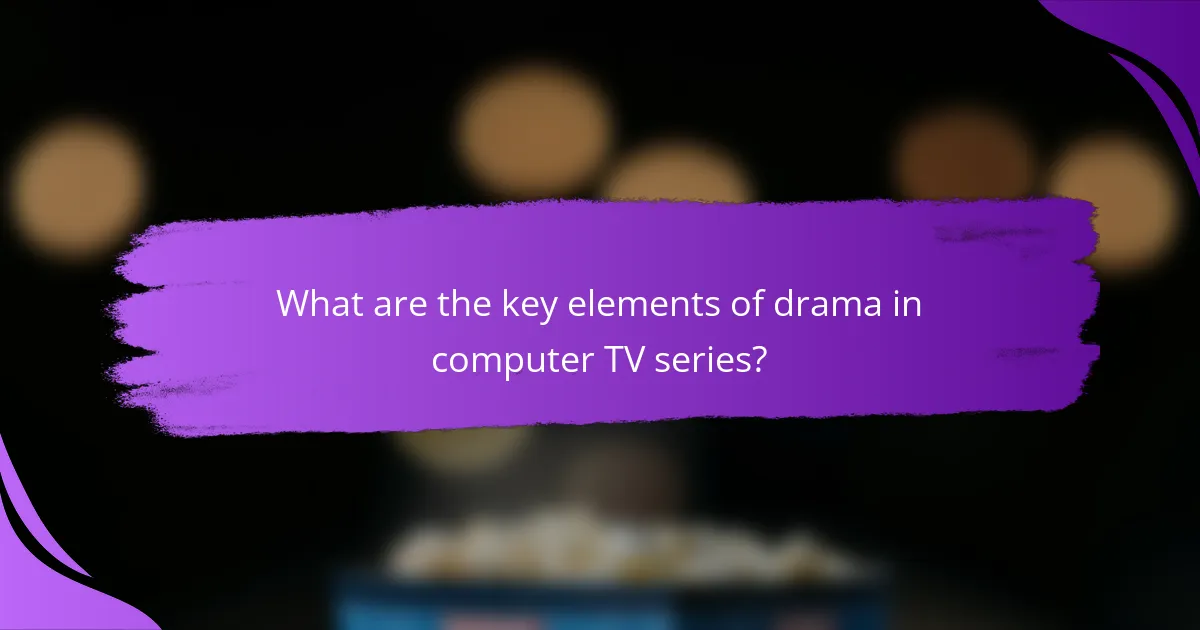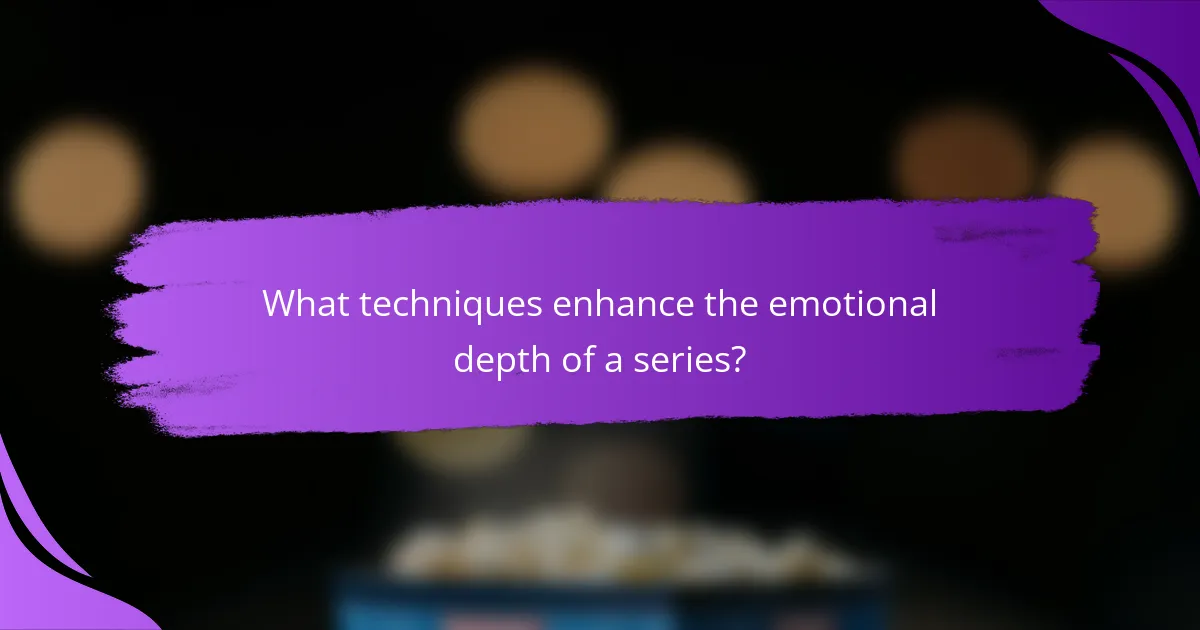The article analyzes the key elements of drama in computer TV series, focusing on character development, plot twists, and emotional depth. Character development fosters personal connections between viewers and characters, driving the narrative forward. Plot twists introduce unexpected developments that engage the audience, while emotional depth adds complexity to characters and situations, evoking empathy and excitement. The evolution of character arcs is examined, highlighting how characters transform over time through challenges and growth. Additionally, the article explores techniques that enhance emotional resonance, including thematic exploration and visual storytelling, which contribute to a compelling viewing experience.

What are the key elements of drama in computer TV series?
The key elements of drama in computer TV series include character development, plot twists, and emotional depth. Character development allows viewers to connect with characters on a personal level. This connection often drives the narrative forward. Plot twists keep the audience engaged by introducing unexpected developments. These surprises can change the direction of the storyline dramatically. Emotional depth adds layers to the characters and situations. It evokes feelings such as empathy, tension, and excitement. Together, these elements create a compelling and immersive viewing experience.
How does character development contribute to drama in these series?
Character development significantly contributes to drama in these series by creating relatable and evolving characters. This evolution allows audiences to form emotional connections with the characters. As characters face challenges, their growth often leads to heightened tension and conflict. For example, a character’s transformation can lead to unexpected decisions that drive the plot forward. Furthermore, well-developed characters often reveal deeper themes and moral dilemmas. This complexity adds layers to the narrative, enhancing viewer engagement. Research indicates that audiences are more invested in stories with dynamic characters, as they reflect real-life struggles and growth. Thus, character development is essential for creating impactful drama in these series.
What techniques are used to portray character growth?
Character growth is portrayed through techniques such as dynamic dialogue, internal conflict, and visual symbolism. Dynamic dialogue reveals changes in a character’s perspective and relationships. Internal conflict showcases a character’s struggle with their beliefs or desires, leading to evolution. Visual symbolism, like changes in wardrobe or setting, reflects a character’s emotional journey. Additionally, character arcs illustrate transformation through challenges and resolutions. These techniques effectively depict the complexity of character development in narratives.
How do character relationships enhance dramatic tension?
Character relationships enhance dramatic tension by creating conflict and emotional stakes. When characters have complex relationships, their interactions can lead to misunderstandings and confrontations. This tension keeps the audience engaged and invested in the outcome. For example, in “Breaking Bad,” the relationship between Walter White and Jesse Pinkman is fraught with betrayal and loyalty. Their dynamic escalates the stakes of each decision they make. Studies show that relationships with conflicting goals amplify tension in narratives. This principle applies across various genres, making character relationships crucial for effective storytelling.
What role do plot twists play in computer TV series?
Plot twists in computer TV series serve to enhance narrative complexity and engage viewers. They create unexpected turns that challenge audience assumptions. This unpredictability keeps viewers invested in the storyline. Plot twists can also deepen character development by revealing hidden motivations or secrets. For example, a character’s betrayal can transform their perceived role in the story. Additionally, plot twists can provoke emotional reactions, such as shock or excitement. This emotional engagement reinforces viewer loyalty to the series. Ultimately, plot twists are a crucial tool for maintaining suspense and interest in the plot.
How can plot twists impact viewer engagement?
Plot twists significantly enhance viewer engagement by creating surprise and emotional investment. They challenge audience expectations and stimulate curiosity. This leads to increased attention and discussion among viewers. Research indicates that shows with effective plot twists retain higher viewer ratings. For example, a study by the University of Southern California found that unexpected plot developments can boost audience satisfaction and loyalty. Engaging plot twists also encourage viewers to re-watch episodes to catch missed clues. This contributes to deeper analysis and understanding of character motivations and themes. Overall, plot twists serve as a critical tool in maintaining viewer interest and emotional connection.
What are some notable examples of effective plot twists?
Notable examples of effective plot twists include the reveal of Keyser Söze in “The Usual Suspects.” This twist redefines the entire narrative and character motivations. Another example is the ending of “Fight Club,” where the protagonist discovers he is Tyler Durden. This twist highlights themes of identity and consumerism. In “Game of Thrones,” the Red Wedding shocks viewers with unexpected character deaths, altering the power dynamics. “The Sixth Sense” features the twist that Dr. Malcolm Crowe is dead, reshaping the film’s emotional impact. Each of these twists significantly changes the viewer’s perception of the story and its characters.
Why is emotional depth important in drama?
Emotional depth is important in drama because it enhances audience engagement and connection. Deep emotions allow viewers to empathize with characters. This connection fosters investment in the storyline. Studies show that emotional narratives can increase viewer retention. For example, a 2018 study by the University of California found that emotionally charged scenes led to higher viewer satisfaction. Emotional depth also adds complexity to character development. Complex characters often reflect real human experiences. This realism resonates with audiences, making the drama more impactful.
How do writers create relatable emotional experiences?
Writers create relatable emotional experiences by developing authentic characters and relatable situations. They ensure characters exhibit genuine emotions that audiences can recognize. Writers often draw from real-life experiences to enhance authenticity. They use dialogue that reflects how people actually speak, making interactions believable. Additionally, writers establish conflicts that resonate with universal human experiences, such as love, loss, and struggle. This connection fosters empathy in the audience. By employing descriptive language, writers evoke sensory details that immerse viewers in the emotional landscape. Furthermore, pacing and timing of plot developments can heighten emotional impact, allowing audiences to process feelings effectively.
What impact does emotional depth have on audience connection?
Emotional depth significantly enhances audience connection. It fosters empathy and relatability between characters and viewers. When characters exhibit authentic emotions, audiences are more likely to invest in their journeys. Research shows that emotionally resonant storytelling can increase viewer engagement by up to 60%. This connection encourages audiences to reflect on their own experiences and feelings. The depth of emotion can also lead to stronger word-of-mouth recommendations. Overall, emotional depth is a critical factor in maintaining audience interest and loyalty.

How do character arcs evolve throughout a series?
Character arcs evolve throughout a series by showcasing the transformation of characters over time. Initially, characters often display specific traits or flaws. As the series progresses, they encounter challenges that prompt growth. This growth can lead to changes in beliefs, relationships, or goals. For instance, a character may start as selfish but become altruistic after facing consequences. The pacing of this evolution varies based on the narrative structure. Flashbacks and character backstories often provide context for their development. In successful series, character arcs align with overall plot progression. This alignment enhances emotional engagement for the audience. Ultimately, well-crafted character arcs contribute to the depth and richness of the story.
What are the different types of character arcs?
There are three main types of character arcs: the positive arc, the negative arc, and the flat arc. A positive arc shows a character’s growth and transformation toward a better version of themselves. This arc often involves overcoming obstacles and learning important lessons. An example is the character of Tony Stark in the Marvel Cinematic Universe, who evolves from a self-centered billionaire to a selfless hero.
A negative arc illustrates a character’s decline or moral degradation. This type of arc often involves succumbing to darker impulses or making poor choices. An example is Walter White from “Breaking Bad,” who transitions from a mild-mannered teacher to a ruthless drug lord.
A flat arc features a character who remains largely unchanged despite the events around them. These characters often serve as a moral compass or stabilizing force for others. An example is Sherlock Holmes, who retains his intellect and methods throughout various challenges. Each type of arc plays a crucial role in character development and storytelling in drama.
How do protagonists and antagonists differ in their arcs?
Protagonists and antagonists differ significantly in their character arcs. Protagonists typically experience growth, change, or transformation throughout the narrative. They often face challenges that lead to self-discovery or moral development. In contrast, antagonists usually embody a static arc, maintaining their core beliefs and motivations. Their role often involves opposing the protagonist, which reinforces the protagonist’s journey. This contrast is evident in many stories, where protagonists evolve, while antagonists remain resolute in their goals. For example, in “Breaking Bad,” Walter White transforms from a mild-mannered teacher to a ruthless drug lord. Conversely, Gus Fring remains a calculated and unyielding antagonist throughout the series. This dynamic creates tension and drives the plot forward.
What is the significance of static vs. dynamic characters?
Static characters remain unchanged throughout a story, while dynamic characters undergo significant development. The significance lies in how these character types influence narrative and audience engagement. Static characters often serve as a contrast to dynamic characters, highlighting their growth. This contrast can create tension and deepen the plot. Dynamic characters typically drive the story forward through their transformations. Their development can evoke emotional responses from the audience. Static characters provide stability and can embody themes or moral lessons. Both types are essential for a balanced narrative structure.
How do character decisions drive the plot?
Character decisions drive the plot by influencing the direction and outcome of the story. Each choice made by a character creates consequences that propel the narrative forward. For example, a character’s decision to confront an antagonist can lead to a climactic confrontation. This confrontation may resolve existing conflicts or introduce new challenges. Furthermore, character decisions reveal their motivations and personal growth. Such developments engage the audience and deepen emotional investment in the story. When characters make pivotal choices, it often leads to plot twists that enhance suspense. These twists keep viewers engaged and eager to see the next unfolding events. Ultimately, character decisions are essential in shaping the narrative structure and pacing of the plot.
What are some examples of pivotal character decisions?
Pivotal character decisions are crucial moments that significantly alter a character’s trajectory. For example, in “Breaking Bad,” Walter White decides to embrace his criminal identity, leading to his transformation into Heisenberg. In “Game of Thrones,” Ned Stark chooses to uphold his honor, ultimately resulting in his execution. In “The Walking Dead,” Rick Grimes decides to spare a life, impacting group dynamics and future conflicts. Each decision shapes the narrative and influences other characters’ paths. These moments create tension and drive the story forward.
How do these decisions affect the storyline’s progression?
Decisions made by characters significantly influence the storyline’s progression. These choices can alter character relationships and drive plot developments. For instance, a character’s decision to betray a friend can create conflict and lead to a pivotal plot twist. Additionally, decisions often reveal character motivations and deepen emotional connections. When a character chooses to sacrifice their safety for another, it enhances the emotional depth of the narrative. Each decision can lead to branching storylines, affecting the overall trajectory of the plot. In interactive narratives, player choices directly shape the storyline, resulting in multiple possible outcomes. This dynamic engagement keeps the audience invested in the unfolding drama.

What techniques enhance the emotional depth of a series?
Techniques that enhance the emotional depth of a series include character development, thematic exploration, and visual storytelling. Character development allows viewers to connect with characters on a personal level. When characters undergo significant growth or face relatable challenges, it evokes empathy. Thematic exploration deepens emotional resonance by addressing universal issues such as love, loss, and identity. This relevance can lead to a more profound viewer experience. Visual storytelling, through cinematography and color palettes, can evoke specific emotions, enhancing the overall impact. Techniques like music scoring also play a pivotal role, as soundtracks can amplify emotional moments. Research indicates that well-crafted narratives with these techniques lead to stronger audience engagement and emotional responses.
How does music and sound design contribute to emotional impact?
Music and sound design significantly enhance emotional impact in drama. They create atmospheres that evoke specific feelings. For instance, a suspenseful score can heighten tension during critical scenes. Conversely, soft melodies may evoke nostalgia or sadness. Research indicates that music influences mood and perception. A study by Juslin and Västfjäll (2008) found that music can induce strong emotional responses. Sound design also adds depth to storytelling. It can emphasize character emotions and plot developments. Together, music and sound design shape audience experiences profoundly.
What role does silence play in creating tension?
Silence serves as a powerful tool in creating tension. It heightens anticipation and allows the audience to fill in the emotional gaps. In dramatic scenes, silence can emphasize character emotions and reactions. This absence of sound forces viewers to focus on visual cues and body language. For example, in suspenseful moments, silence can amplify fear or uncertainty. Studies in film theory suggest that silence can be more impactful than dialogue. It creates a pause that can lead to unexpected plot developments. Overall, silence effectively manipulates audience emotions and enhances dramatic tension.
How can background scores influence viewer emotions?
Background scores can significantly influence viewer emotions by setting the tone and enhancing the narrative experience. Music can evoke specific feelings, such as tension, joy, or sadness, aligning with the visual elements of a scene. For instance, a slow, somber score can amplify feelings of loss during a dramatic moment. Research indicates that emotional responses to music are often immediate and visceral, affecting heart rate and mood. A study published in the Journal of Experimental Psychology found that music can alter perception and interpretation of visual stimuli. The integration of background scores in film and television is a deliberate choice to manipulate audience emotions effectively.
What narrative structures are effective in conveying drama?
Effective narrative structures for conveying drama include linear, non-linear, and circular storytelling. Linear storytelling presents events in chronological order. This structure allows for clear cause-and-effect relationships. Non-linear storytelling disrupts chronological flow. It can create suspense and intrigue by revealing information out of order. Circular storytelling begins and ends at the same point. This structure emphasizes character development and thematic resonance. Each structure engages audiences differently, enhancing emotional depth. For instance, shows like “Breaking Bad” utilize non-linear elements to build tension. In contrast, “The Crown” often employs linear storytelling for clarity in character arcs. These structures are essential in creating impactful drama.
How does non-linear storytelling affect emotional engagement?
Non-linear storytelling enhances emotional engagement by creating a complex narrative structure. This approach allows viewers to piece together story elements in a non-sequential manner. As a result, it fosters deeper connections to characters and themes. Research indicates that non-linear narratives can evoke stronger emotional responses. A study by Green and Brock (2000) found that engaging with fragmented narratives increases empathy towards characters. This emotional investment is heightened as viewers actively interpret the storyline. Non-linear storytelling also encourages surprise and intrigue, keeping audiences more engaged. Overall, this narrative style effectively deepens the emotional experience for viewers.
What are the benefits of using flashbacks and foreshadowing?
Flashbacks and foreshadowing enhance storytelling by providing depth and context. Flashbacks reveal a character’s past, enriching their development and motivations. They help viewers understand current actions and emotions. Foreshadowing builds anticipation and tension. It hints at future events, keeping the audience engaged. Both techniques create a layered narrative structure. They encourage viewers to piece together information. This results in a more immersive viewing experience. Studies show that these techniques can increase viewer satisfaction and emotional investment in the story.
What practical tips can enhance the analysis of drama in computer TV series?
To enhance the analysis of drama in computer TV series, focus on character development, plot structure, and emotional resonance. Analyze character arcs to understand their growth and motivations. Observe plot twists for their impact on narrative tension and audience engagement. Examine dialogue for subtext and emotional depth. Consider the use of visual storytelling elements, such as cinematography and color, to convey themes. Pay attention to pacing and how it affects tension and resolution. Research critical reviews to gain diverse perspectives on themes and character dynamics. Use episode summaries to track plot progression and thematic evolution.
The main entity of this article is the analysis of drama in computer TV series, specifically focusing on character development, plot twists, and emotional depth. The article examines how character development fosters viewer engagement through relatable characters and evolving relationships, while plot twists enhance narrative complexity and maintain audience interest. It also emphasizes the importance of emotional depth in storytelling, detailing techniques that writers use to create relatable emotional experiences. Additionally, the article discusses various narrative structures and their effectiveness in conveying drama, providing practical tips for analyzing these elements in TV series.